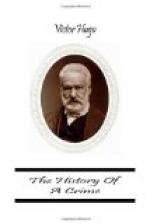Suddenly a man who had entered the courtyard, and who had attentively watched him for some moments, came abruptly up to him,—
“What are you doing there?”
“What is that to you?” said Gindrier.
“You have come to fetch Baudin’s body?”
“Yes.”
“Is this your carriage?”
“Yes.”
“Get in at once, and pull down the blinds.”
“What do you mean?”
“You are the Representative Gindrier. I know you. You were this morning on the barricade. If any other than myself should see you, you are lost.”
Gindrier followed his advice and got into the fiacre. While getting in he asked the man:
“Do you belong to the Police?”
The man did not answer. A moment after he came and said in a low voice, near the door of the fiacre in which Gindrier was enclosed,—
“Yes, I eat the bread, but I do not do the work.”
The two men sent by the Commissary of Police took Baudin on his wooden bed and carried him to the fiacre. They placed him at the bottom of the fiacre with his face covered, and enveloped from head to foot in a shroud. A workman who was there lent his cloak, which was thrown over the corpse in order not to attract the notice of passers-by. Madame L—— took her place by the side of the body, Gindrier opposite, young Baudin next to Gindrier. A fiacre followed, in which were the other relative of Baudin and a medical student named Duteche. They set off. During the journey the head of the corpse, shaken by the carriage, rolled from shoulder to shoulder; the blood began to flow from the wound and appeared in large red patches through the white sheet. Gindrier with his arms stretched out and his hand placed on its breast, prevented it from falling forwards; Madame L—— held it up by the side.
They had told the coachman to drive slowly; the journey lasted more than an hour.
When they reached No. 88, Rue de Clichy, the bringing out of the body attracted a curious crowd before the door. The neighbors flocked thither. Baudin’s brother, assisted by Gindrier and Duteche, carried up the corpse to the fourth floor, where Baudin resided. It was a new house, and he had only lived there a few months.
They carried him into his room, which was in order, and just as he had left it on the morning of the 2d. The bed, on which he had not slept the preceding night, had not been disturbed. A book which he had been reading had remained on the table, open at the page where he had left off. They unrolled the shroud, and Gindrier cut off his shirt and his flannel vest with a pair of scissors. They washed the body. The ball had entered through the corner of the arch of the right eye, and had gone out at the back of the head. The wound of the eye had not bled. A sort of swelling had formed there; the blood had flowed copiously through the hole at the back of the head. They put clean linen on him, and clean sheets on the bed, and laid him down with his head on the pillow, and his face uncovered. The women were weeping in the next room.




